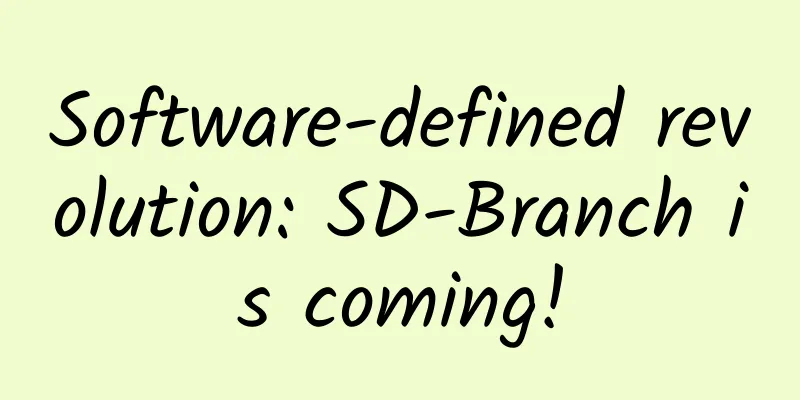Software-defined revolution: SD-Branch is coming!

|
Software is taking over the world, and software-defined networking is expanding to every aspect of networking, completely changing the way we think about, configure, and deploy networks.
SD-WAN provides enterprises with a variety of options. Compared with MPLS, SD-WAN provides greater network flexibility, lower costs, and more control over WAN connections. From SD-WAN to SD-BranchSD-Branch is the next step for SD-WAN. The improvements in visibility and control that SD-WAN provides for the WAN have been extended to the branch LAN as well. SD-Branch provides a common interface for configuring, monitoring and troubleshooting multiple functions such as routing, switching, Wi-Fi, network security, micro-segmentation and application support, eliminating the need to use separate user interfaces for each function. With SD-Branch, the hardware platform with the virtual device installed will replace the original typical network device set, which is not only simpler but also has greatly enhanced maintenance capabilities. If new firewall functions are needed, only the firewall virtual instance needs to be updated; assuming that BGP is not needed in the router, only the image without BGP can be installed. The installation of new software takes into account new features and functions, which is usually achieved by replacing the hardware platform. SD-Branch is more than just automationSome might compare SD-Branch to using automation. SD-Branch is a more holistic approach that provides a unified user interface for monitoring, management, and troubleshooting. It can use multiple components under the hood but hides this implementation detail. SD-Branch, similar to SD-WAN, supports the definition of policies that define connectivity, quality of service, and security for endpoints and applications. For example, an SD-Branch product can be used to define new VLANs, provision across routers, switches, and Wi-Fi infrastructure, and add application and security policies. Automation is often focused on lower-level network configuration and control, often performing one function at a time. Enterprises and users need to implement automated processes for every functional element of the infrastructure. SD-Branch can turn policy definitions into actions, not just network automation. Advantages of SD-BranchA centralized control point makes it easier to manage multiple sites. All branches need to be consistent, and consistency can use the same interface for the same functions. Improved IT security is a major benefit of SD-Branch. Standardization of security policies eliminates the possibility of the network being attacked by intruders due to slightly different site configurations. Currently, large DMZ boundary firewalls are outdated. Centralized control of security policies can help enterprises or users better protect IoT devices from intrusions and make it easier to deploy new security practices such as SASE and zero-trust network access. Security needs to be universal and consistent - SD-Branch is an important step to achieve this goal. Because SD-WAN is an integral part of SD-Branch, routing can be optimized through custom policies to ensure that application traffic is on the link that best meets application needs. Centralized control extends to LAN configuration. Network monitoring and troubleshooting are easier when VLAN configurations are consistent. When changes are needed, applying them to all branches becomes simple. Disadvantages of SD-BranchSD-Branch is a new field, and there are no interoperability standards between vendors. Enterprises must choose a vendor whose products best meet their requirements, but this also means that they may not be able to obtain the best capabilities in some aspects of branch visibility and control. Because it is very likely that one product does a better job in visibility and troubleshooting, while another product best meets the needs of defining and applying security policies. If an enterprise has many branch sites that use unique designs (often called snowflake networks), then SD-Branch may not be as advantageous. Standardizing sites is the best approach in the long run and can reduce operating costs. The Future of SD-BranchThe scope of software-defined everything will continue to expand, and network equipment will become more standardized and easier to manage. In the future, we may even see the disappearance of command line interfaces, replaced by programmable interfaces driven by centralized control systems, and future network operations will become more simplified and easier to understand. Original link: https://www.nojitter.com/enterprise-networking/software-defined-revolution-making-sd-branch-possible |
<<: China Mobile launches A-share listing: "Making money" but not "cutting leeks"
>>: 5G refreshes your digital reading experience
Recommend
Under the epidemic, networks in various countries have failed, but Chinese operators are still the strongest at the critical moment!
Under the epidemic, what is tested is not only hu...
Hyperscale Data Centers vs Micro Data Centers
Some say the data center of the future is very di...
AkkoCloud: US CN2 GIA/Germany CN2 GIA/UK CN2 GIA line VPS annual payment starts from 299 yuan
AkkoCloud is a Chinese hosting company founded in...
The future of communication in "no man's land" depends on them! Satellite Internet accelerates the arrival of 6G
[[349172]] In sparsely populated deserts and Gobi...
Wang Chunhui: 5G releases three major functions to drive China on the path of high-quality development
On June 6, 2019, the Ministry of Industry and Inf...
[6.18] ZJI: Hong Kong Kwai Wan server limited 30% off, 20% off for all, 999 yuan to enjoy 1100 yuan voucher
ZJI released the 618 event plan. On the basis of ...
Kaspersky Managed Detection and Response Service receives top rating in Garter Peer Insights
Kaspersky’s Kaspersky Managed Detection and Respo...
5G means data center platforms must evolve
The foundation for seamless 5G implementation 5G ...
DogYun Spring Festival discount: 30% off on Dynamic Cloud, 20% off on Classic Cloud, save 100 yuan per month on dedicated servers, and get 10 yuan for every 100 yuan you top up
The traditional Lunar New Year is approaching, an...
From a technical perspective, the development of 5G industrialization will become clear after reading this article
1. Market demand Mobile Internet is mainly orient...
What should you know about 5G technology? What will happen in the future?
The most memorable coverage of 5G cellular networ...
LOCVPS New Year Promotion: Netherlands VPS 40% off, starting from 22 yuan, Singapore VPS/Russia VPS/Hong Kong VPS 30% off
LOCVPS (Global Cloud) is a long-established Chine...
LinkSure Network attended the International World Wide Web Conference (WWW2017) and published a paper
From April 3rd to April 7th, the International Wo...
Unveiling the mystery of MPLS, do you know all this?
Before formally learning MPLS, let us review the ...
CrownCloud: AMD Ryzen series KVMs are now available in Los Angeles data center, starting at $5 per month
CrownCloud is a foreign VPS hosting company found...








![[6.18]DogYun: 30% off on Elastic Cloud, 20% off on Classic Cloud, 68 yuan free for 618 yuan top-up, Hong Kong/Korea dedicated servers starting from 300 yuan/month](/upload/images/67cabe7853916.webp)
